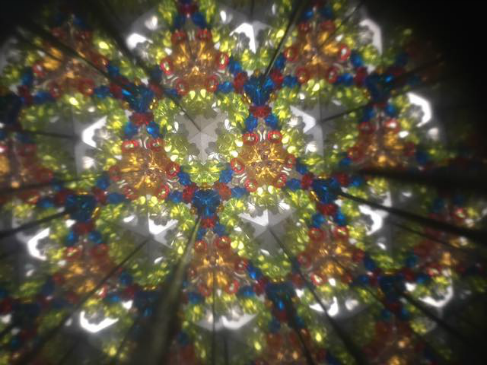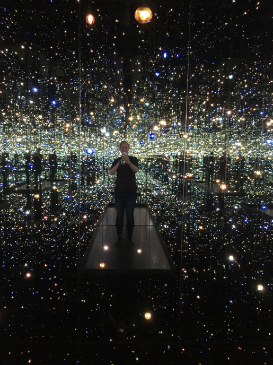Show people the picture below and most of them will recognise the beautiful image created by a kaleidoscope. However, not many will be able to explain how you construct one or how it works and fewer still would see the educational benefit in studying them in school.

In my wander around the stunning world of geometry I’ve been investigating a variety of historical and cultural areas. Recently, this has included this wonderful diversion.
 The invention of the kaleidoscope, in 1816, is credited to Scottish inventor, mathematician, physicist, astronomer, writer and historian Sir David Brewster. Called the “the Johannes Kepler of modern optics” (Whewell, 1859) Brewster is recognised for his work on stereoscopes and instruments of photography (amongst other things).
The invention of the kaleidoscope, in 1816, is credited to Scottish inventor, mathematician, physicist, astronomer, writer and historian Sir David Brewster. Called the “the Johannes Kepler of modern optics” (Whewell, 1859) Brewster is recognised for his work on stereoscopes and instruments of photography (amongst other things).
Brewster first noticed the beauty in multiple reflections whilst conducting experiments concerning light polarisation. This was followed by the multiple reflections of a piece of cement in a triangular trough, which provoked him to study the conditions for aesthetically satisfying symmetrical patterns and to develop the kaleidoscope.
Multiple reflections have been discussed since antiquity but it was Brewster’s observation of the beauty of his environment, his willingness to be distracted by this observation and his interest in its elegance that resulted in its creation.
So where’s the maths?
Firstly let’s think about double reflections. How could you place two mirrors? What would be the results? Why do those results occur?
Let’s simplify: start with a pair of parallel mirrors and one object. What effect does the placement of the object have? How do I get an infinite number of copies of my object? Can I get an infinite pattern? Do I always get an infinite number of reflections? Are the images always equally spaced out?
Here’s an example I mocked up using Geogebra. How was each image formed? How many reflections occurred to create each image? Is there more than one sequence of reflections?

 Let’s think about a pair of mirrors joined to form a V shape. When do I get symmetrical images? Is there anything significant about the angle between the two mirrors? Why is this important?
Let’s think about a pair of mirrors joined to form a V shape. When do I get symmetrical images? Is there anything significant about the angle between the two mirrors? Why is this important?
A kaleidoscope is made quite simply from a tube, some bright beads (or similar), three mirrors and a view hole. The three mirrors are joined such that the cross section forms an equilateral triangle.
If we concentrate on one vertex of the equilateral triangle what would we see? Why? What’s the significance of my diagram below?  Have a go at reproducing this with your own mirrors (maybe not a teapot).
Have a go at reproducing this with your own mirrors (maybe not a teapot).
 Now let’s consider an equilateral triangle and two gems.
Now let’s consider an equilateral triangle and two gems. 
Each edge of the triangle to the left is a mirror hence our first reflections produce the design to the right.
As further reflections are completed a tiling of the plane is produced.
Here are a few more reflections using Geogebra. How was each image formed?
 I constructed this using reflections in the edges of the highlighted initial object. It’s challenging to see how to get the tiling but really gets your visualisation skills working!
I constructed this using reflections in the edges of the highlighted initial object. It’s challenging to see how to get the tiling but really gets your visualisation skills working!
Multiple reflections produce stunning and fascinating results. Take a look at the work of Japanese artist Yayoi Kusama: here’s my colleague Ellen (an infinite number of times) at an exhibit called Infinity Mirrors at The Broad, LA (https://www.thebroad.org/)

Reference: William Whewell (1859) History of the Inductive Sciences. D. Appleton. p. 133
|
SOMETHING TO TRY:
KS1: Place two mirrors in the corner of the classroom at 90˚. Ask pupils to create patterns by laying down 2D tiles and talk about what they see. Pupils can then recreate the total pattern using the 2D shapes on a large plain sheet with a ┼
KS2: Place two mirrors parallel to each other. Ask pupils to place an object between the mirrors and talk about what they see. Pupils can reproduce a diagram of the reflections such as

How is each image created? Describe the pattern of reflections from the initial object to each image. How many reflections are needed to create each image? Is there any way of predicting whether an odd or even number of reflections are needed? Why?
KS3: If you join two mirrors along one edge to form a V and place an object inside this V, what angles give symmetrical results? Why? In each case how many instances of the object are there? Is there a way of calculating this in advance for any angle? How?
KS4: Investigate the design of the kaleidoscope. In this design the triangle formed by the cross-section of the mirrors is equilateral. What would happen if it was isosceles? Right angled? Not a triangle but another regular polygon? Would any other polygons result in a tiling of the plane? Why?
KS5: In the discussion above it is assumed that we are working in a perfectly horizontal world and that the mirrors are vertical. What if a pair of mirrors was place on the surface below. What would happen? Why?

|